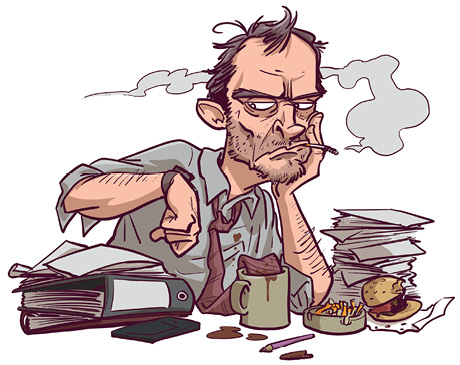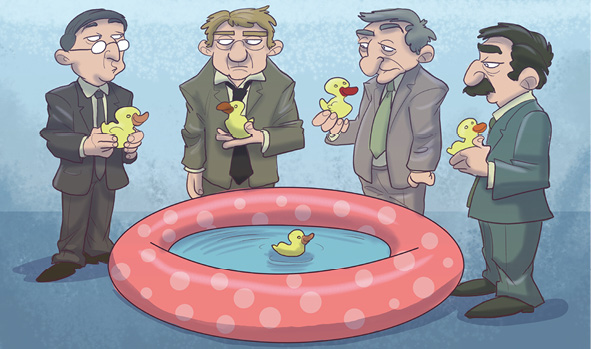What Are You Waiting For? Change Your Life
The million-dollar question: how many times in your life have you made the decision to change something? To lose weight, to say no, to tell a colleague your opinion, to stop smoking, to look for another job. Next question: how many of these things have you actually achieved? If you’re currently mumbling a vague answer and feeling the urge to skip this section, do not fret! Humans are all the same. We all have goals; we all strive for change—but the implementation can often go awry. Are you aware of the two key drivers that can really help you effect change? If not, let me introduce pain and desire. No change can function without at least one of these sensations—and you’re welcome to test this theory for yourself.

Let’s begin with pain. When are most people really prompted to lose weight? The motivation comes, for example, when the individual concerned has severe physical symptoms and is left with no choice but to finally drop the extra pounds. Alternatively, a person might bump into their one-time crush at a ten-year reunion and, instead of falling enthusiastically at their feet, think only, “Wow, you’ve gained weight!” This is often sufficient as a motivation to take action. As far as smoking is concerned, there is one measure—admittedly very drastic—that rarely fails to take effect. Smokers under hypnosis are mentally connected to a heart-lung machine and required to say goodbye to their family—for best results, to small children. Incidentally, any desire of mine to smoke and take drugs was lost during my time in the ambulance service, where my various conversations en route to the lung clinic left a serious and lasting impression.
Now, let’s turn to the second factor: the desire to do something. Are you one of those who find it impossibly difficult to learn a foreign language? Take my Uncle Rainer, who fell in love with a Chinese lady at the age of sixty-four but had the problem that his dear lady spoke neither German nor English. The desire was greater than the pain, and within a short time, Rainer was speaking quite decent Chinese.
The concept can be extended to other areas of life. How often do you really issue an unconditional “no” in the workplace? If pain is solely what drives you, this will probably only occur at the point when your desk is heaving at the point of collapse. But when the factor of desire comes into play—for example, if you’re eagerly anticipating a concert in the evening—a staunch “no” becomes the medium of choice in the face of additional tasks. In a similar vein, when’s the last time you really told a colleague your opinion, when your level of ire became so intense that you couldn’t hold back any longer? When’s the last time you and a colleague found a fresh understanding after a company outing, and you sought out a quiet moment to tell them the things that were bothering you? My advice is simply to be honest and stop sugar-coating the issues.
Some time ago, I had a client who was completely burnt-out from his work. When I asked if there was anything positive about it at all, he replied, “Sometimes, when someone’s having a birthday, there’s cake and sparkling wine.” Well, then—cheers!
Pain and desire influence our decisions. They move us to make a difference, to change things. At points in my journey, I, too, have resisted taking action for change until I was hit by the painful realization that I am not living my passion.
My work as a coach has allowed me to gain plentiful experience of the things that instill desire and pain—and one story stands out especially in my memory.
Some time ago, I received a call from the managing director of a parts manufacturer in the automotive industry. “Are you this motivational mogul I’ve been hearing about?”
I confirmed, laughing, and inquired what he was looking for.
“Well, none of our drones came to the Christmas party this year, and I wondered if you’d be able to do anything about it,” he said.
Drones? Had he really just referred to his employees as “drones”?
“Well, I’d say your employees probably hate you,” I concluded, appealing for a chance to talk at his company.
My first encounter with these “drones” stays with me to this day. We met in a room filled with beer tables and a small stage. The room was chock-full of the same image: people who were still standing, but were mentally and emotionally dead. I embarked cheerfully on my talk on motivation and gratitude and reaped a mixture of empty looks and ignorance. Suddenly, one of the employees jumped to his feet. “So, you really have it all?” he yelled. “I’m putting a stop to this, you asshole. Take your motivational shit home.” The room was revived, and there was a standing ovation from his colleagues. Just as the Titanic had crashed into an iceberg in 1912, so I was standing in front of a similar obstacle now. I tried not to go under.
All right, Beck, new plan! I asked for a short break and telephoned the manager. “There’s a little problem with this group,” I whispered into the phone. “No, to be honest, there’s a big problem.”

“So—you too!” the boss replied. “Last week, we had someone come to do some in-company education. All the employees had to make a duck and race it in a paddling pool!” At that moment, I realized something. In-company education? No wonder the group wasn’t responsive anymore. “I have an idea,” I said to the manager.
As I explained my brainwave, I was forced to insist—for the second time that day—that I was still in possession of my senses. Instead of twenty-five ducks, I ordered twenty-five sports cars for the employees to play with. The rest of the day was spent breathing life back into my participants at 130 miles per hour on the highway. These people needed to feel the value of what they were doing, that they and their work were needed. At the end of the day, we sat together in a much-improved mood and reflected on our time together. A couple of them even offered the occasional smile—a rather unusual sight during working hours.
I asked the heckler from the morning’s talk to sum up his job in one sentence. He grinned. “I’m racing a car, you asshole!” Everyone laughed—but this time, I laughed along. Incidentally, the company today has brightly painted walls, a saltwater aquarium, and its own brass band, which passes through the rooms every Friday to create a good atmosphere. What’s more, the employees volunteer in a nearby kindergarten and give back to society. Since my time at the company, the managing director has recorded a significant increase in productivity and has revised his management style by attending a number of training courses. He’s been particularly grateful for a falling sickness rate: when people enjoy going to work, they don’t fall ill with every bug going.

So, what have we learned from this story? Yes, that nothing changes without pain or desire. These people were not aware that their important work made them part of a much bigger end product. Only through the driving experience did they gain access to this realization. When you’re thinking about changing something, your next question should always be, “What’s my reason?” Where is the incentive for you to really live your change? Is it really possible for you to progress further at work, or are you standing still?
To illustrate this clearly, I want to tell you a little story. Are you familiar with the definitions of thermometer and thermostat? A thermometer measures the temperature; the thermostat is responsible for regulating temperature and keeping it at a certain level. As humans, we mentally record the temperature from morning until night, and since our brains are geared to protecting ourselves from danger, we’re drawn to wherever our “comfort” temperature prevails. But in the shelter of a cave, growth is rather difficult—which is why we need people to adjust our thermostat for us.
I was in Singapore for a refresher course when I met a US coach over a coffee break. We got along great, exchanged ideas, and, at some point, began to talk about our industry. Rather boldly, I asked him what he earns (incidentally, unlike in Germany, this is not a problem for Americans, because talking about money is completely normal in the United States). He mentioned a number—$25,000—and I impressed upon him that it was a good monthly turnover. He looked at me with some frustration and said, “Not per month, my friend, per day.”
I struggled to keep my composure. “How can that be possible?” I wondered. Here was someone who made more money in one day than I did in my previous life as a flight attendant in a year. At that moment, I experienced a fascinating thought. I asked myself, “Why not? If he can, I can too.” My thermostat was, figuratively speaking, newly reset, and I decided to invest more in my personal development. I would need to venture further into too-hot or too-cold areas to get closer to my goal. But more on that later.
Write down the thermostats—the goals—of your life:
